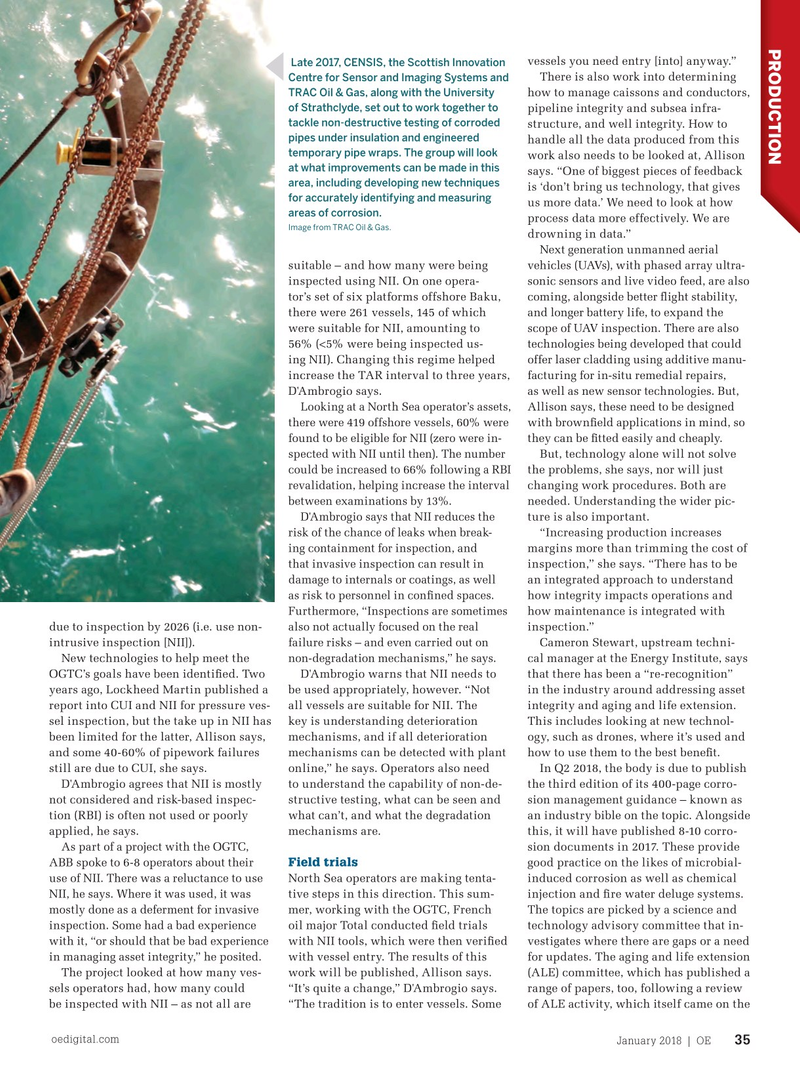
Page 33: of Offshore Engineer Magazine (Jan/Feb 2018)
Read this page in Pdf, Flash or Html5 edition of Jan/Feb 2018 Offshore Engineer Magazine
PRODUCTION vessels you need entry [into] anyway.” Late 2017, CENSIS, the Scottish Innovation
There is also work into determining
Centre for Sensor and Imaging Systems and how to manage caissons and conductors,
TRAC Oil & Gas, along with the University of Strathclyde, set out to work together to pipeline integrity and subsea infra- tackle non-destructive testing of corroded structure, and well integrity. How to pipes under insulation and engineered handle all the data produced from this temporary pipe wraps. The group will look work also needs to be looked at, Allison at what improvements can be made in this says. “One of biggest pieces of feedback area, including developing new techniques is ‘don’t bring us technology, that gives for accurately identifying and measuring us more data.’ We need to look at how areas of corrosion. process data more effectively. We are
Image from TRAC Oil & Gas.
drowning in data.”
Next generation unmanned aerial vehicles (UAVs), with phased array ultra- suitable – and how many were being sonic sensors and live video feed, are also inspected using NII. On one opera- coming, alongside better ? ight stability, tor’s set of six platforms offshore Baku, and longer battery life, to expand the there were 261 vessels, 145 of which scope of UAV inspection. There are also were suitable for NII, amounting to technologies being developed that could 56% (<5% were being inspected us- offer laser cladding using additive manu- ing NII). Changing this regime helped facturing for in-situ remedial repairs, increase the TAR interval to three years, as well as new sensor technologies. But,
D'Ambrogio says.
Looking at a North Sea operator’s assets,
Allison says, these need to be designed there were 419 offshore vessels, 60% were with brown? eld applications in mind, so found to be eligible for NII (zero were in- they can be ? tted easily and cheaply.
But, technology alone will not solve spected with NII until then). The number the problems, she says, nor will just could be increased to 66% following a RBI changing work procedures. Both are revalidation, helping increase the interval needed. Understanding the wider pic- between examinations by 13%. ture is also important.
D'Ambrogio says that NII reduces the “Increasing production increases risk of the chance of leaks when break- margins more than trimming the cost of ing containment for inspection, and inspection,” she says. “There has to be that invasive inspection can result in an integrated approach to understand damage to internals or coatings, as well how integrity impacts operations and as risk to personnel in con? ned spaces. how maintenance is integrated with
Furthermore, “Inspections are sometimes due to inspection by 2026 (i.e. use non- inspection.” also not actually focused on the real intrusive inspection [NII]). Cameron Stewart, upstream techni- failure risks – and even carried out on
New technologies to help meet the cal manager at the Energy Institute, says non-degradation mechanisms,” he says.
OGTC’s goals have been identi? ed. Two D'Ambrogio warns that NII needs to that there has been a “re-recognition” years ago, Lockheed Martin published a be used appropriately, however. “Not in the industry around addressing asset report into CUI and NII for pressure ves- all vessels are suitable for NII. The integrity and aging and life extension. sel inspection, but the take up in NII has key is understanding deterioration This includes looking at new technol- been limited for the latter, Allison says, mechanisms, and if all deterioration ogy, such as drones, where it’s used and and some 40-60% of pipework failures mechanisms can be detected with plant how to use them to the best bene? t. still are due to CUI, she says. online,” he says. Operators also need In Q2 2018, the body is due to publish
D'Ambrogio agrees that NII is mostly to understand the capability of non-de- the third edition of its 400-page corro- not considered and risk-based inspec- structive testing, what can be seen and sion management guidance – known as tion (RBI) is often not used or poorly what can’t, and what the degradation an industry bible on the topic. Alongside applied, he says. mechanisms are. this, it will have published 8-10 corro-
As part of a project with the OGTC, sion documents in 2017. These provide
Field trials
ABB spoke to 6-8 operators about their good practice on the likes of microbial-
North Sea operators are making tenta- induced corrosion as well as chemical use of NII. There was a reluctance to use tive steps in this direction. This sum- injection and ? re water deluge systems.
NII, he says. Where it was used, it was mer, working with the OGTC, French The topics are picked by a science and mostly done as a deferment for invasive oil major Total conducted ? eld trials technology advisory committee that in- inspection. Some had a bad experience with NII tools, which were then veri? ed vestigates where there are gaps or a need with it, “or should that be bad experience with vessel entry. The results of this for updates. The aging and life extension in managing asset integrity,” he posited.
The project looked at how many ves- work will be published, Allison says. (ALE) committee, which has published a sels operators had, how many could “It’s quite a change,” D'Ambrogio says. range of papers, too, following a review be inspected with NII – as not all are “The tradition is to enter vessels. Some of ALE activity, which itself came on the oedigital.com
January 2018 | OE 35 034_OE0118_Prod1_aset integ.indd 35 12/27/17 7:15 PM

 32
32

 34
34